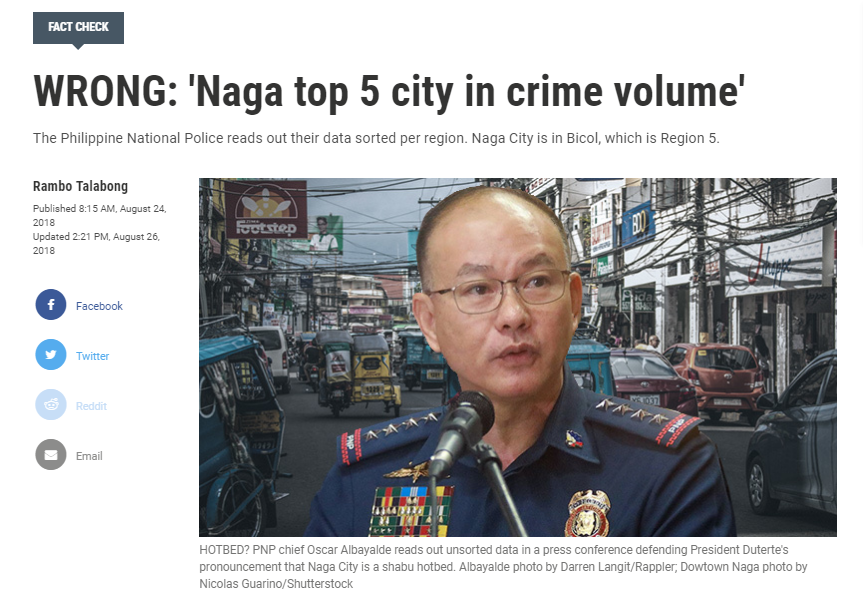Rappler Explains Nuances of Crime Statistics

Screengrab from Rappler.
LAST AUGUST 14, President Rodrigo Duterte said he did not want to “suggest a Constitutional succession” should he resign the presidency. He said Maria Leonor “Leni” Robredo cannot “improve on anything” in case she succeeds him, claiming that Naga City, the hometown and bailiwick of the vice president was a “hotbed” of shabu (metamphetamine).
A week later, the Philippine National Police held a press briefing in which PNP Director-General Oscar Albayalde announced that Naga City is the 5th most crime-ridden among chartered cities, and was similarly ranked in the first semester of 2017 and 2018. The PNP said Duterte’s claim has a basis, as they see a correlation between crime rates and the extent of the drug problem.
Numbers don’t lie, but these can be misinterpreted, whether intentionally or not.
CMFR cheers Rappler for fact-checking the PNP’s own data, and for pointing out that crime statistics, as released to the public by the police, are far from nuanced.
On August 24, Rappler reported that Albayalde had misread the PNP’s own data, since the chartered cities in the list were arranged by region and not by crime volume. Naga City is in Bicol, or Region 5.
PNP Spokesperson Benigno Durana, who provided Albayalde the data, apologized for the “oversight,” and said he was solely responsible for any inconvenience it may have caused. But after retracting its claim on Naga City’s being the 5th highest in crime volume in the entire country, the PNP released on August 25 data showing that the city had the highest average monthly crime rate.
A separate Rappler story explained the difference between crime volume and crime rate. Crime volume is the total of all crimes— against persons and property and in violation of special laws—committed in an area over a time period. The crime rate, meanwhile, is computed by dividing the crime volume by a certain area’s population. The result is then multiplied by 100,000. The formula measures the number of crimes per 100,000 residents.
Upon checking, the police said Naga is only 16th in crime volume, after Davao City. But they said the average monthly crime rate of Naga City from January to July 2018 was 202.8.
Rappler pointed out that neither crime rate nor crime volume presents an accurate picture of crime prevalence, as both lump together crimes without taking into account that some are graver than others.
“This means that cities with low murder and homicide rates can garner higher crime rates simply by having high theft and robbery rates, or having more public smokers caught by cops,” said Rappler.
Analyzing the crime volume statistics provided by the PNP, Rappler reported that Naga City ranked low in grave crimes such as murder, homicide and rape, but ranked high on robbery and theft, which are classified as petty crimes.
The online news site also quoted Albayalde, who said “those who are perpetrating these crimes against properties are really those also engaged in the drug trade, illegal drugs,” but did not provide data showing which cities are most affected.
The Duterte administration has a penchant for exaggerating claims on drugs and crime without much basis or explanation, as evidenced by his release of a so-called “narco-list” and his tagging of opposition figures as being involved in drugs. Rappler looked beyond the data as presented by the police and provided the analysis needed for the public to understand what they mean.
Duterte’s inaccurate claim provided an opportunity for an alert media to clarify the meaning of crime statistics, something that police officials and even the president use for their propaganda.
Leave a Reply